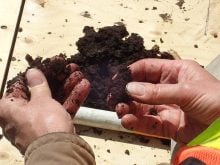Manitoba trials show a fertilizer recycled from waste water has promise as an organic phosphorus amendment — if it’s approved for organic use, that is.
“Phosphorus is a non-renewable source,” said researcher Joanne Thiessen Martens. “We need to be thinking about recycling as much as possible.
Read Also

Mandatory holiday joy a valid struggle
Christmas may not be that jolly for everyone. Farm family coach Kalynn Spain suggests those struggling with over-the-top joy during the holidays instead aim for “fulfilled” or “content.”
Phosphorus deficiencies are common on organic farms because of lack of good fertilizer options.
Thiessen Martens, a PhD candidate at the University of Manitoba’s department of soil science, trialled struvite on three crops between 2017 and 2019 at Libau in eastern Manitoba. She shared her findings during the Prairie Organics Conference on February 8.
Struvite is a phosphorus-rich crystalline material that can naturally occur in nutrient-rich waste water treatment systems if conditions are right — potentially clogging the system.
Fun fact: struvite is also what makes up kidney stones as per the National Kidney Foundation’s website.
Nutrients can be precipitated out of waste water in a more controlled fashion and turned into a white, granular fertilizer that’s rich in phosphorus, some nitrogen and magnesium. It can also be made from manure and food waste.
Struvite is not very soluble in water, Thiessen Martens said. In neutral or acidic soils, much of it will dissolve over time.
The Libau study looked at what struvite application rate would support good crop yields without raising soil phosphorus too much, and without suppressing arbuscular mycorrhizal fungi (AMF), which assists plants in taking up nutrients.

The soil at Libau was alkaline, making it challenging conditions for struvite to dissolve — which was what Thiessen Martens wanted. All three years were dry, but not to an extreme like 2021.
In spring 2017, she banded struvite at three different rates into an existing stand of alfalfa-grass forage. The stand was depleted and performing poorly. She didn’t apply struvite in 2018 or 2019.
Thiessen Martens found that forage yield increased with higher struvite application rates. However, this effect grew stronger over the second and third year.

“It really seemed like that struvite was sort of living up to its slow-release reputation,” she said, adding it could also be because the plants were able to access more phosphorus in the subsequent years.
The control plot, with no struvite applied, was dominated by grasses, Thiessen Martens said. The fertilized plots were dominated by alfalfa. It had no effect on weeds.
Besides forage quality implications, this also has implications for organic producers who are using alfalfa to fix nitrogen in soil. With very little alfalfa in a forage stand, it will fix very little nitrogen.
Thiessen Martens planted wheat and flax with three rates of struvite application banded with the seed. She repeated this in 2018 and 2019.
She saw a gradual increase in yield with increased application rates.
“Not as dramatic as with the alfalfa,” she added. “It was there and it was significant.”
It took higher rates to get an increase, she added. At the highest rate, she saw some suppression of AMF, but not much different from the control plot.
Flax alone essentially didn’t respond to the struvite, but it’s not responsive to phosphorus fertilizer in general, said Thiessen Martens.
“Overall, from this study, it does seem that struvite is pretty promising as a phosphorus source,” Thiessen Martens said.
“In general, we needed really high rates to achieve those yield increases, but the interesting thing was there was lots of struvite left over for future crops,” she added.
She showed a photo of partially dissolved struvite granules in the soil. It was slowly dissolving and releasing phosphorus.
Unfortunately, struvite is not really available to organic farmers, said Thiessen Martens. Canadian organic standards allow struvite from non-human sources, but to her knowledge none is commercially available in Canada.
Human-source struvite is commercially available.















